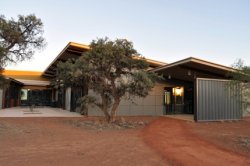
Affiliation:
Part of the Sustainable Ecosystems Division of CSIRO (Commonwealth Scientific & Industrial Research Organisation)
Mailing address:
CSIRO Sustainable Ecosystems, Alice Springs
PO Box 2111
Alice Springs NT 0871
Australia
E-Mail: ashley.sparrow@csiro.au
Research focus
The Alice Springs laboratory of CSIRO is part of the Australia-wide Commonwealth Scientific and Industrial Research Organisation. This national science agency has the vision of “igniting the creative spirit of our people to deliver great science and innovative solutions for industry, society and the environment” (more information at Weblink). From Alice Springs, we conduct research on ecology, natural resource management and socio-economic systems in Australia’s drylands.
The Environment of the Location
The Alice Springs laboratory (23° 45′ 26 S, 133° 52′ 46 E) is located at the centre of Australia’s drylands. Alice Springs has a mean annual rainfall of 286 mm that is slightly summer dominant. However, rainfall is highly variable and any month can be completely dry. Summers are hot (daily maximums in the high 30s to low 40s) and winters cool (night time temperatures close to 0o C). The laboratory is located on the alluvial plains of the ephemeral Todd River to the south of the picturesque MacDonnell Ranges. Alice Springs has a population of 27,000 with tourism being important to the local economy. Grazing of cattle is the most extensive regional land use with conservation and Aboriginal occupation being other important land uses. Alice Springs services an increasingly important mining industry in the more remote deserts of inland Australia.(Weblink)
Short history and milestones
CSIRO established a presence in inland Australia in the late 1940s when it conducted a series of regional land resource inventories and published land system maps and accompanying resource descriptions. By 1953, CSIRO had based a scientist permanently in Alice Springs who conducted research into developing the pastoral industry. By the 1980s extensive research had been conducted to understand the ecology of grazed rangelands and to develop methods for monitoring grazing impact. This work continued at larger scales into the 1990s with the application of monitoring methods based on remote sensing. There was also considerable investment during this period on the application of decision support software to assist pastoralists with sustainable land management in the face of considerable climate variability. Research into improved conservation in the drylands commenced in the 1980s, initially on fire and its management, then extending to GIS-based conservation planning in parks and reserves. This work broadened to include interactions between grazing and biodiversity creating a foundation for planning and negotiating off-reserve conservation. CSIRO’s research in central Australia has increasingly included the interaction of people with the dryland environment, with current research focused on sustainable livelihoods for Aboriginal people.
Current research
The Alice Springs laboratory currently has eight research scientists and two support staff. Our research and its impact is broadened through connections with the Desert Knowledge Cooperative Research Centre (Weblink). This CRC is a research and brokerage institution that links researchers with 28 partners working across desert Australia.
Current research has a focus on sustainable livelihoods for Aboriginal people. This is driven by issues that include:
- A high proportion of land ownership and population in the Australian rangelands is Aboriginal,
- the aspirations of the Aboriginal people are often different to that of non-indigenous Australians,
- meeting these aspirations is a key challenge of sustainable development of the rangelands.
In conjunction with the Desert Knowledge CRC, we are developing partnerships with Indigenous communities to develop culturally appropriate ecosystem service-based livelihood options that fulfil community aspirations to participate in regional economies while maintaining landscape health. Research projects include: engaging Indigenous partnerships, Livelihoods inLand™ and the prospective economic value of bush produce. (Weblink)
Research with a biophysical focus includes:
- impacts (pastoral and biodiversity) and management of weed invasions, particularly buffel grass (Cenchrus ciliaris); (Weblink)
- landscape health and monitoring (Weblink), including coordination of the Australian Collaborative Rangeland Information System; and
- off-reserve conservation, based on improved understanding of how native plants and animals use landscapes that are highly variable, and developing stewardship and incentive schemes that would reward management directed at biodiversity outcomes. (Weblink)

